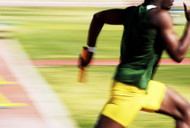|
Everything you do requires energy. Whether you're sitting on the sofa digesting a Sunday dinner, or in the gym struggling with an overly ambitious exercise program, you're always burning energy (calories). But, again, no matter what activity you're doing, your body is powered by one compound... adenosine triphosphate (ATP). ATP is the 'energy currency' of the human body and it's only stored in very small amounts (about 3 seconds worth) so the body must replace ATP continually. If we can get to grips with how it does this we can fully understand the energy systems and make our workouts more productive. Creatine Phospahte Now it starts getting complicated but bear with me. ATP is made up of one adenosine and three phosphates (A+P+P+P). When a molecule of ATP is combined with water (a good reason to stay hydrated) the last phosphate splits away and releases energy. Now there is one adenosine and two phosphates. This is called adenosine DI-phosphate (ADP) or (A+P+P). To replenish the lost phosphate there are a few systems in place which power the production of ATP. The first system is called the Phosphocreatine System (PCr system for short) which is made up of one creatine and one phosphate. I fear I'm at risk of losing your attention with all of this chemistry nonsense and I can't even promise you it's worth it! (Sad face). So, when the initial ATP stores have ran out, after about 3 seconds, you're left with a load of ADPs which are useless without the third 'P'. Your body cleverly calls upon its PCr store to lend some phosphates to the ADPs. Now the ADP is ATP again and everyone's happy for the 3 to 15 seconds of energy it gives. The Glycolytic System (Muscle and Liver Glycogen) The second system is the Glycolytic System. This system relies on the food we eat. The carbohydrates can be stored in the muscles or liver as glycogen. This glycogen then gets converted in to pyruvic acid then goes through an overly complicated process called The Krebs Cycle to eventually produce ATP. This is called aerobic gycolysis (the breakdown of glucose in the presence of oxygen). Here's how it works (This is optional reading.... Seriously, if you don't like the sciency bits, skip the next paragraph): The Krebs Cycle: Through catabolism of sugars, fats, and proteins, a two carbon organic product acetate in the form of acetyl-CoA is produced. Acetyl-CoA along with two equivalents of water (HO) are consumed by the citric acid cycle producing two equivalents of carbon dioxide (CO) and one equivalent of HS-CoA. In addition, one complete turn of the cycle converts three equivalents of nicotinamide adenine dinucleotide (NAD) into three equivalents of reduced NAD (NADH), one equivalent of ubiquinone (Q) of into one equivalent of reduced ubiquinone (QH), and one equivalent each of guanosine diphosphate (GDP) and inorganic phosphate (P) into one equivalent of guanosine triphosphate (GTP). The NADH and QH that is generated by the citric acid cycle is in turn used by the oxidative phosphorylation pathway to generate energy richadenosine triphosphate (ATP). However, in the absence of oxygen, the glycogen can be converted to lactic acid. This is called anaerobic glycolysis. Other terms that are used are fast glycolysis (if the final product is lactic acid) and slow glycolysis (if the final product is pyruvate), which then goes through the Krebs cycle. As its name would suggest the fast glycolitic system can produce energy at a greater rate than slow glycolysis. However, because the end product of fast glycolysis is lactic acid, it can quickly accumulate and is thought by some to lead to muscular fatigue. The Oxadative System (Fat) Ok, last one now; The Oxadative System. This is similar to the Glycolytic system except that the end product, pyruvic acid, is converted into a substance called acetyl co-enzyme-A. This goes through the Krebs cycle and produces two ATP's. The waste product, hydrogen, goes through the electron transport chain and produces another 34 ATP's!
Another difference between the two systems is that the Oxadative System can produce ATP through the combustion of fat in the presence of oxygen via something called lipolysis. So if you want to burn fat while you're exercising... breath. In other words, you're always burning fat, but at different rates depending on the type and duration of exercise.
0 Comments
Leave a Reply. |
AuthorThe Fitness Rooms Blog is put together by some of the leading personal trainers in Harrogate. Archives
March 2014
|
ServicesPersonal Trainer Harrogate
Fitness Classes in Harrogate Private Gym Membership |
Company |
Support |
Website Design by My Personal Trainer Website
|


 RSS Feed
RSS Feed